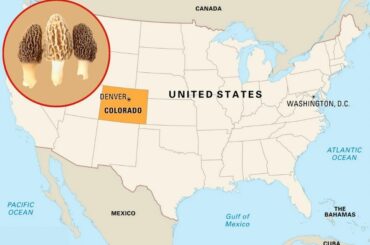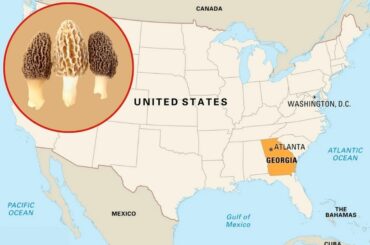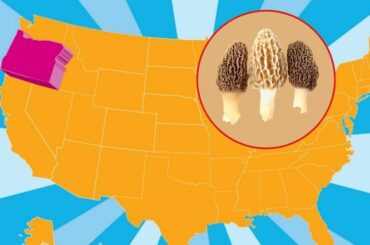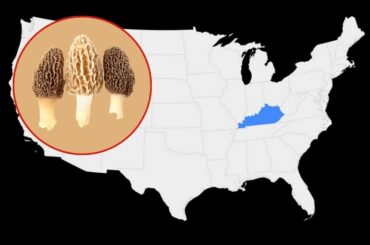Mushrooms are saprophytic fungi and spread worldwide. Their reproductive organ is the spore. There are two types of spores: sexual spores and asexual spores. These mushrooms grow in the fruiting body of the mushroom. The spores are located at the underside of the fruiting body, and that part is called the gills. A dried mushroom spore’s ability to grow is determined by the amount of heat it is exposed to, such as direct sunlight or temperatures above 120 °F. But can you grow mushrooms from dried mushrooms?
The short answer is Yes. There are some drying techniques to dry mushrooms. When using these drying techniques, we can protect the mushroom spores alive during the drying process and that kind of dried mushrooms can grow again because the spores are alive.
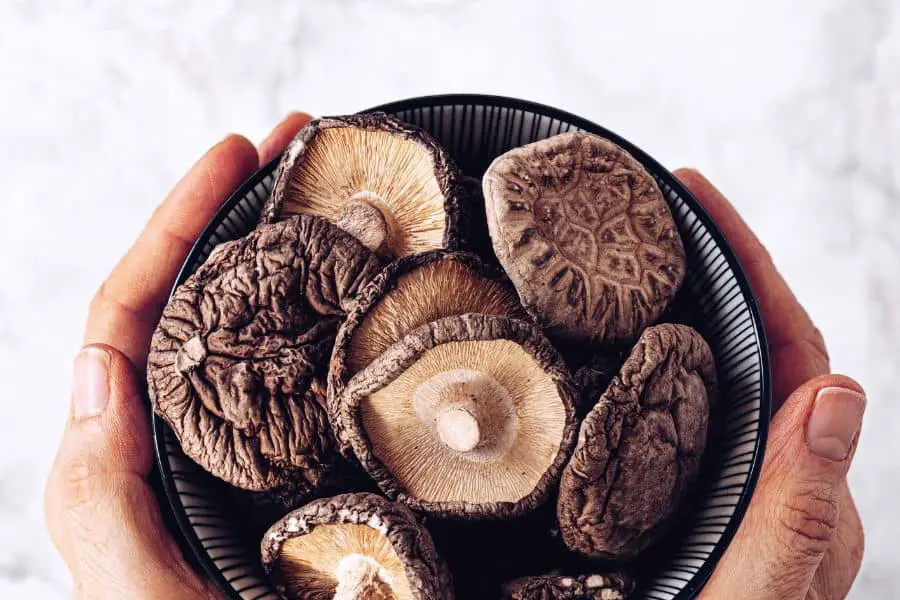
But this method is very difficult and needs more patience to get success. To get success with this method you need the proper sterilization techniques and suitable equipment, experience with mushroom cultivation, and well-controlled environmental conditions.
There are some risks when you are drying the mushrooms. The mushrooms are very easily contaminated with other fungi or bacteria. This contamination affects the growth of new mycelium. To avoid these risks, we use sterilization techniques and always keep our hands clean during drying and other processes.
Things to consider
Contents
- 1 Things to consider
- 2 How to grow mushrooms from dried mushrooms (step-by-step guide)
- 3 How to rehydrate mushroom spores
- 4 How to revive dry mycelium
- 5 Can you clone from dried mushrooms?
- 6 Can I grow mushrooms from store-bought mushrooms?
- 7 Liquid culture from dried mushroom
- 8 Related questions: Can You Grow Mushrooms From Dried Mushrooms
- Mushroom variety
- Method of drying
- Duration of dehydration
How to grow mushrooms from dried mushrooms (step-by-step guide)
Dried mushrooms are not that much of a good source for growing and it needs good practice. But the mushrooms can grow using dried ones if the spores are not destroyed while drying.
The steps of growing mushrooms from dried ones are:
- Select the mushroom type
- Dehydrate the mushrooms
- Rehydrate the mushrooms
- Collecting the spores
- Adding the spores to the growth media
- Incubating the spores
Select the mushroom type
When drying some mushroom spores destroy at very low temperatures. The other point is some mushroom spores can’t rehydrate once they are dried. Therefore when selecting mushrooms you have to be concerned about these factors.
Dehydrate the mushrooms
The selected mushrooms are dehydrated using sunlight or in open-air conditions. Direct sunlight is not suitable and it may damage the spores. When drying the mushrooms, the mushrooms should be placed separately one by one to ensure complete dehydration.
You can turn over the mushrooms from time to time for better dehydration. The air circulation also should be good for the successful dehydration process.
If the mushrooms dried best, they can keep for six to twelve months without any damage. If you wish to keep them for a long time period the dried mushrooms should be stored correctly as well.
Rehydrate the mushrooms
When you need to grow mushrooms from dried ones, first prepare the tools and other equipment sterile to avoid contamination. Then select the flat surface and place the dried mushrooms on it. Then add two or three water drops for each mushroom to rehydrate them.
The mushroom spores may wash away if an overload of water is added. Then keep the spores in water for 2-3 days for a better rehydration process.
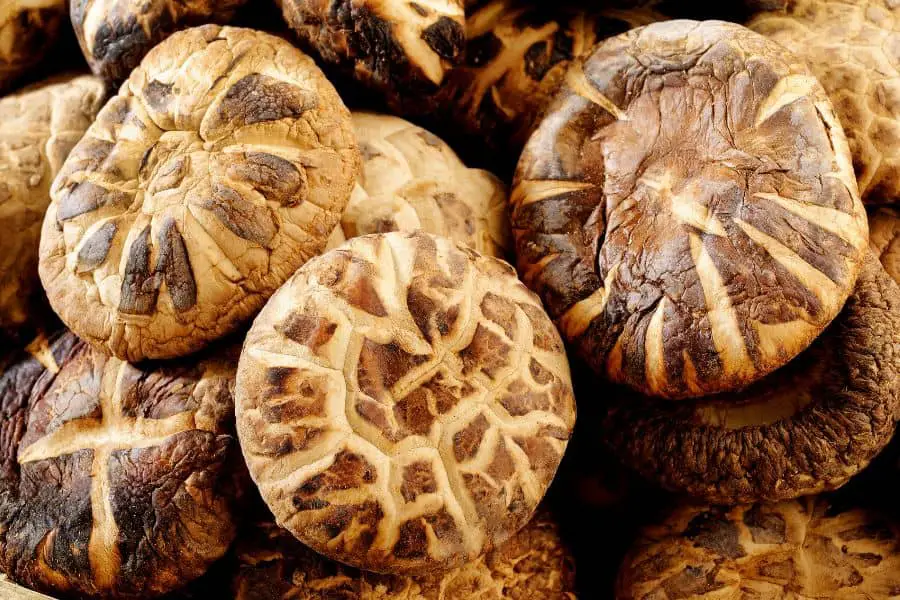
Collecting the spores
After rehydration well, the mushroom spores can be collected. The mushroom stem and cap should separate before collecting the spores. When cutting the mushroom cap, put it on paper to take a spore print.
Then take spore prints to a piece of paper by putting the paper on a mushroom cap or rolling the paper with the mushroom as a sandwich. Then some weight like a book put on that mushroom cap directly. The spore prints can take to the paper after within 24 to 48 hours.
Adding the spores to the growth media
Then you should use sterilized equipment and sterilized substrate to grow mushroom spores. It is better to follow the steps under sterile conditions to avoid unnecessary contaminations.
Add the sterilized substrate which is prepared using manure and compost, to a tray or use a fruiting chamber. When adding the substrate, add about one inch of the substrate to the tray.
Then carefully scrape the paper which includes mushroom spores and spread the spores on the substrate directly. Follow the above steps under sterile conditions and keep your hands clean during the process also.
The special point is to keep the substrate wet always to continue the growth of mushroom spores.
Incubating the spores
The mushroom growing medium should be kept in the incubator to give a suitable temperature for mushrooms. The temperature is about 70℉ for three weeks time period. Then the temperature should change from 55 ℃ to 60 ℃.
After reducing the temperature of the incubator, the grown mycelium should cover with soil and then the mycelium grows through the soil as mushrooms. Then you can observe that the mushrooms fully grow after three or four weeks.
Then you can harvest the mushrooms and process them as you prefer.
How to rehydrate mushroom spores
The mushroom rehydrating process is also an important step and you should sterilize all the equipment and keep your hands clean during the process. Different rehydrating processes are used to dry mushroom spores.
One method is to rehydrate spores using a spore syringe.
For this method you need:
- Spore print
- Water
- Empty Syringe
- Scalpel
- Tinfoil
- Pair of tweezers
- Pressure cooker
- A gas burner or lighter
As the first step, you should sterilize the water. It is easy to use a small flask covered with tinfoil to do this process because the narrow neck of the flask reduces the risk of contamination. The sterilization process can be done using a pressure cooker for 15 pounds per square inch (PSI) of pressure and for 30 minutes.
Then the flask can be removed from the pressure cooker safely. The flask should be kept aside until the temperature reaches room temperature. Because the high temperatures destroy the mushroom spores.
After cooling the sterilized water, sterilize the scalpel and pair of tweezers using the lighter or gas burner until the equipment gets red hot. Then keep the equipment away from the burner and keep it aside for 20-30 seconds or dip it in sterile water to cool off.
As the next step remove the foil from the small flask which consists of sterile water and scrap the spore print paper into the flask to add dried spores to the water using the scalpel. When doing this process you should not touch the paper which consists of spore print by hand and uses a pair of tweezers.
Then take water which consists of mushroom spores to the syringe and again add the sample to the flask. Repeat the step for a few times to spread the spores well in the water sample. Then take the water sample to the syringe and keep the sample as it is 24 hours or two to three days for a better hydration process.
The syringe with mushroom spores can be kept in the refrigerator at 2-4 ℃ temperature for about 2-6 months for later use.
The other method is :
As with the above method, you should sterilize the equipment before use. The water sample also needs to be sterilized under 15 PSI pressure for 30 minutes. Select a flat surface like a table and scrap the spore print to a petri dish. The petri dish should be sterilized well.
Then add a little amount of water drops (2 or 3 drops) to the spores. Then keep them in an incubator or at room temperature. But there is a high risk of contamination with this method.
How to revive dry mycelium
When mushrooms grow, the first appearing thread is a network called mycelium. These structures can degrade the dead plant and animal parts into organic compounds. But all mycelia do not develop as mushrooms.
Under suitable environmental conditions such as humidity and temperature, they grow up as mushrooms. The mycelia do a great job in ecosystems and they are responsible for decay and renewal.
You can grow mushrooms from dried ones but there isn’t much evidence about growing/ reviving dry mycelium. But if the mycelium dried out under air-blowing conditions they still remain as live organisms.
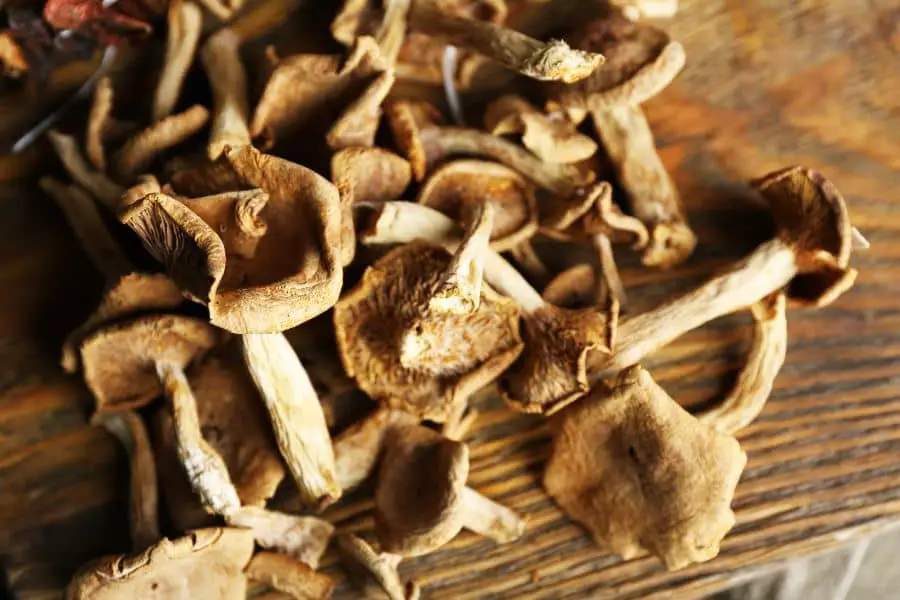
Can you clone from dried mushrooms?
Yes, you can clone from dried mushrooms.
The dried mushrooms should be stored in sterile conditions before starting the cloning process. And the other steps of the cloning process must be done in sterile conditions and must use sterilized equipment.
The first step of cloning the mushroom is rehydrating the dried mushroom. Separate a part of the tissue from the mushroom to clone. A scalpel is used to separate the tissue. The tissue that is used to rehydrate soaks in sterile water.
Then follow up the clone procedures and transfer the tissue to an agar plate. Then let the tissue grow under the proper environmental conditions. But cloning is not a proper way or very suitable way to grow mushrooms.
But the cloning process should not continue for the same mushroom (clone a clone), because it creates weak mushrooms, and finally, the fruiting bodies will not appear or the process will get slow.
Can I grow mushrooms from store-bought mushrooms?
Yes, you can grow mushrooms from store-bought mushrooms. The coffee grounds and straw were used as the substrate for this mushroom-growing method. Coffee grounds are rich in some key nutrients that help the growth of plants. The nutrients are Nitrogen, Potassium, Calcium, Magnesium, Phosphorus, Iron, and Chromium.
As the first step, you have to find fresh mushrooms. These mushrooms should also include mycelium which grows near the base of the mushroom and the mushroom stem needs to be healthy to get the best results.
The grown mycelium on the bottom part of the mushroom looks like white and fuzzy stuff. All the steps and equipment should be sterilized for this method also to prevent contamination. Prepare an empty clean jar and sterilize it before use.
The coffee steams before use and then removes the excess water from the coffee sample. Then add coffee grounds to the jar. When adding coffee, there is no need to add a lot of coffee to the jar. The jar should be filled with about ⅓ amount.
Then add the cut mushroom stems into the jar. Then the mouth of the jar was closed tightly with coffee filter paper. This step helps to prevent contamination and helps to good airflow into the jar. Because gaining oxygen and removing carbon dioxide from the jar is essential for the growth of the mushrooms.
About a week or about eight days after, you can observe the mycelium growing well in the jar and the mycelium spreading into the coffee layer too. Then again some coffee is added to the top of the substrate. Then closed the jar as previously using a new filter paper. To get the best result you can put the jar in a dark area.
Follow the above step weekly for three to four weeks. Then prepare a straw to mix with coffee grounds. Before mixing the straws, the straws should be cut into the size of about a quarter inch and sterilized. Then the well-grown mycelium-coffee sample is added on to a sterilized background like cardboard by scooping.
Then added some sterilized straw to a transparent bag like polyethylene or zip lock bag. Next, add some mycelium-coffee substrate samples into the bag. Then add another straw layer to the bag. Then tighten them well. Repeat the above steps until the bag fills about half or three-quarters or until the mycelium sample finishes.
After filling the bag, tighten the bag as best you can and confirm that there is no excess air in the bag. Then add some pores on the sides and bottom of the bag. The side pores help to grow mushrooms outside of the bag and the bottom pores are used to drain water.
Then the environmental conditions like temperature, humidity, and light should be controlled. Especially the humidity needed at about 85%. After about twenty days the mushrooms come out from the bag. During the above, all process you should keep your hands clean and keep all the steps should do under sterilized conditions.
Liquid culture from dried mushroom
Liquid culture is the culturing method that is used to cultivate bacteria and fungi-like microorganisms. This liquid is sterilized before use. This liquid contains the nutrients that are needed for the growth of microorganisms like fungi.
There are some advantages of using this liquid culturing method in growing mushrooms. Because this makes the contamination risk low but it needs a sterile environment to proceed with the steps.
Take a jar and add water. Then measure sugar and add to the jar. Then mix the sugar and close the jar using the lid (it is an airport jar lid. It has a self-healing hole). Then cover the top lid with aluminum foil and sterilize it using a pressure cooker under 15PSI for 15-20 minutes.
After cooling the jar to room temperature, then take the mother culture and take a few amounts from that culture using a sterile syringe. Then add the sample to the liquid culture through the self-healing hole. Then keep the jar at about 77℉ for four to five days.
Finally, the mycelium grows through the jar. When mycelium covers the jar, it is ready to inoculate to the substrate. Before inoculating the jar should be shaken vigorously to break the mycelium. Then inoculate the mycelium with a suitable agar medium.
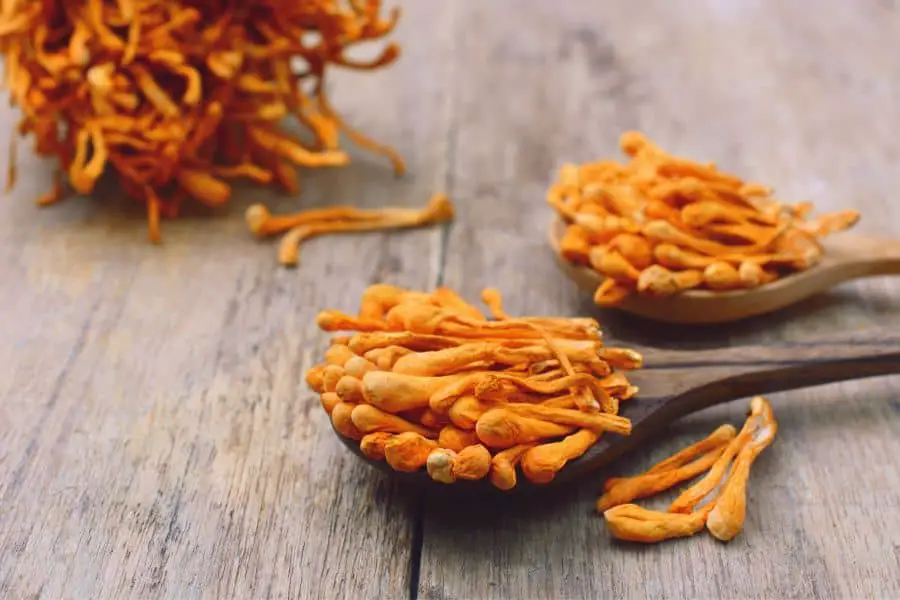
Related questions: Can You Grow Mushrooms From Dried Mushrooms
Can you grow mushrooms from old mushrooms?
There are two answers to the question and they are Yes and No.
You can grow mushrooms from old mushrooms. The harvested mushrooms consist of mycelium on their stem. These mycelia have the growing ability. When these mycelium-consisting mushrooms contact soil and after fulfilling the suitable environmental conditions, they start to grow as mushrooms.
Sometimes the old mushroom stems consist of primordia. The primordia are tiny mushrooms. They can also be called baby mushrooms. These primordia also have the growing ability and when the environmental conditions are favorable, they start to grow.
When harvesting the mushrooms from old ones, you can use straw, hamster, or shredded cardboard ( they are cellulose material) as substrates for the best results. The important point is to moisten the substrate well during the growth period.
The mycelium with substrate should be kept in a cool, dry, moist place to grow the mushrooms well. After 3-4 weeks the mycelium can become fruiting bodies (mushrooms).
The whole process and equipment must sterilize and must be in clean hands always to avoid contamination.
Sometimes you also can’t grow mushrooms from old mushrooms. If the old mushroom dried out and the remaining mycelium was destroyed, you can’t grow them. Environmental conditions also affect this process. If the suitable conditions do not allow for old mushrooms, they will not become new mushrooms.
Read Next : Can You Grow Mushrooms Without Spawn?
Read Next : Log Mushroom Cultivation Common Questions And Answers
Read Next : What Do Mushroom Pins Look Like (In Details)

